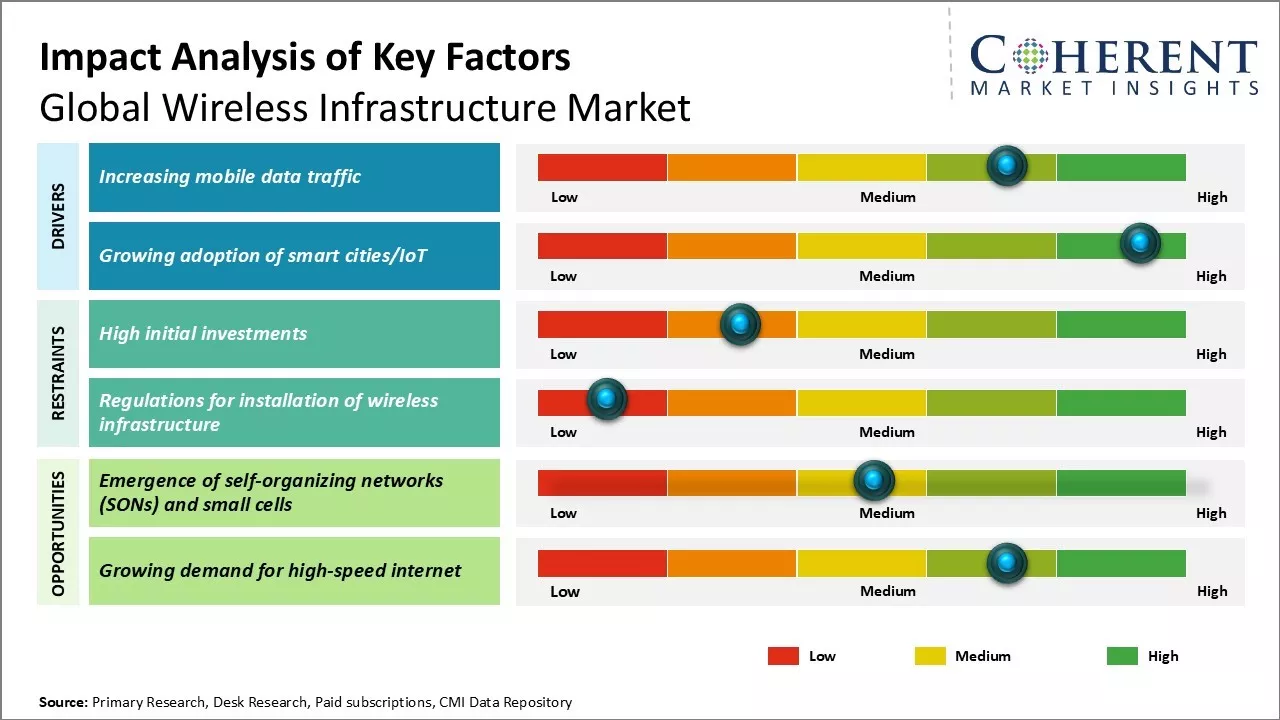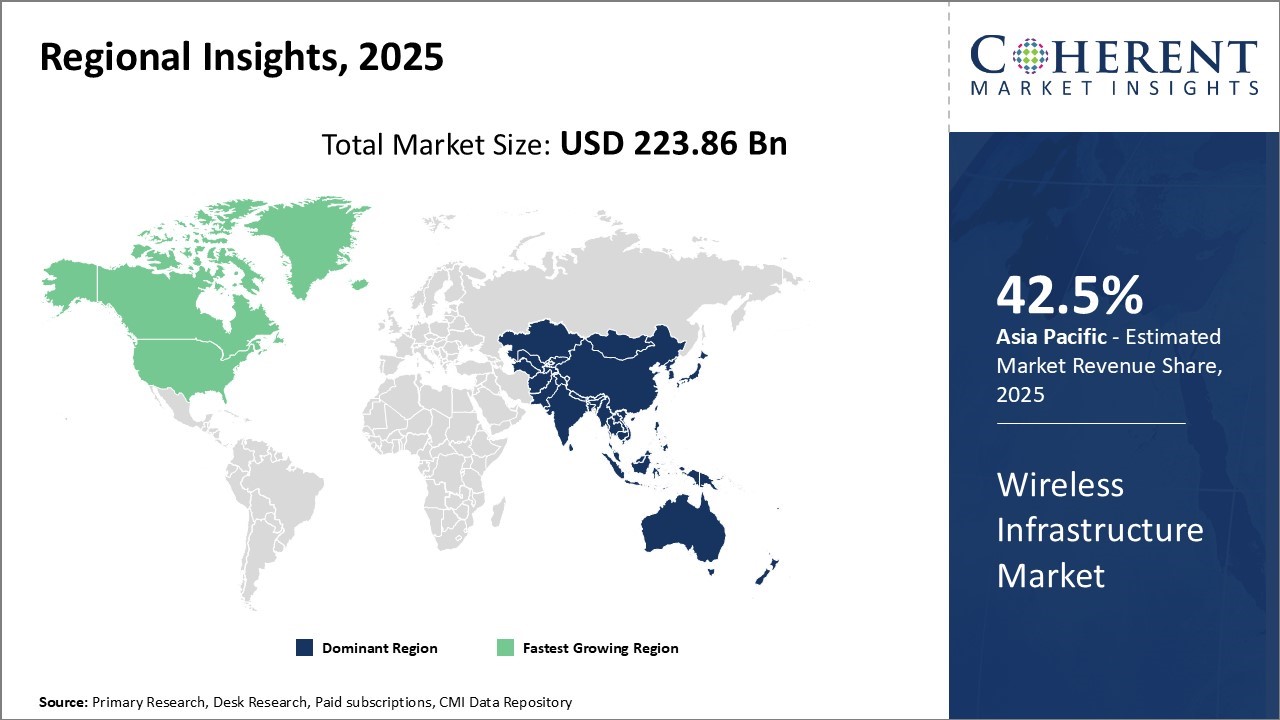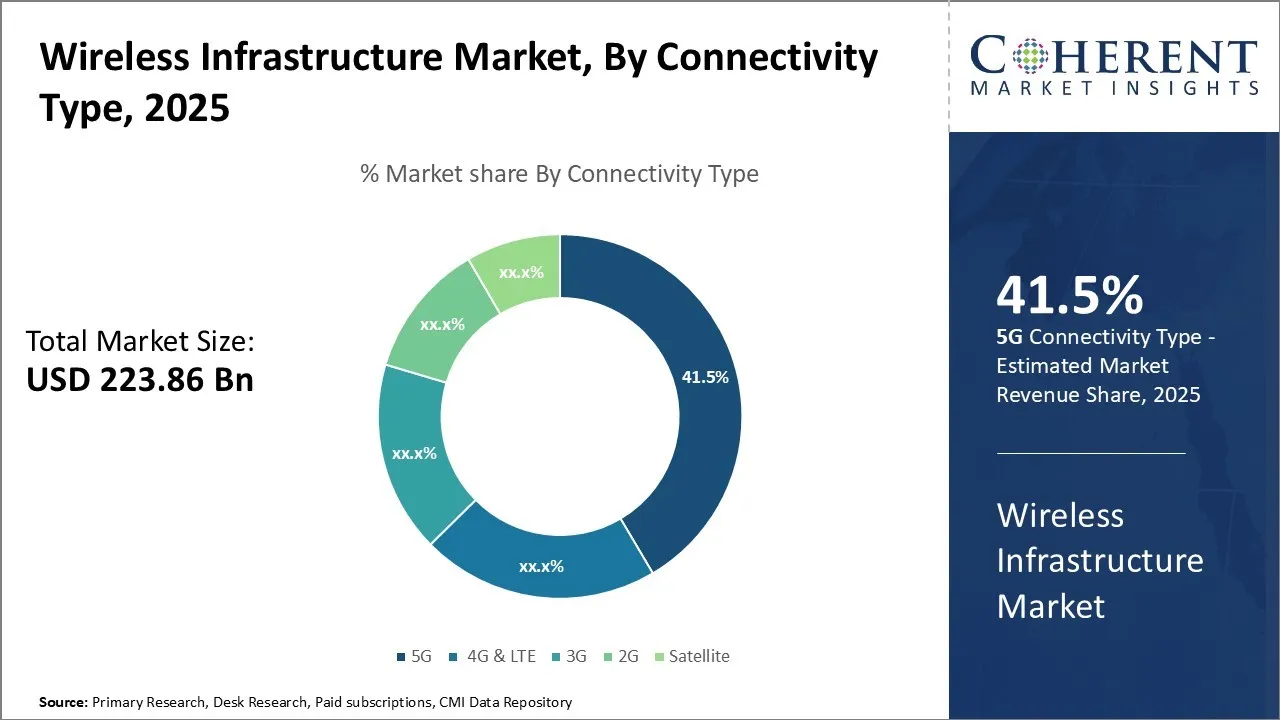Wireless Infrastructure Market Size and Trends
The global wireless infrastructure market is estimated to be valued at USD 223.86 Bn in 2025and is expected to reach USD 553.67 Bn by 2032, exhibiting a compound annual growth rate (CAGR) of 13.8% from 2025 to 2032.
Key Takeaways
- Based on Region, Asia Pacific is dominating the market with 42.5% in 2025, owing to the massive digitalization in countries like India and China.
- Based on Infrastructure, the Small Cells Segment is expected to lead the market in 2025, with 35.1%, due to its ability to help offload data traffic from macro-cellular networks.
- Based on Connectivity type, the 5G segment is dominating with 41.5%, owing to its ability to deliver ultra-fast data speeds and lower latency.
- In terms of Platform, the Government & Defense segment is leading with 33%. The growth is fueled by government initiatives.

To learn more about this report, Download Free Sample
Market Overview
Global wireless infrastructure market growth can be attributed to the increasing adoption of 5G networks across geographies. 5G networks require denser infrastructure to support high-speed and low-latency services. This is expected to drive the demand for small cells and fiber backhaul deployment globally. Furthermore, the rising mobile data traffic and the proliferation of IoT devices are other key factors boosting the wireless infrastructure market demand. Mobile operators are investing heavily in upgrading existing infrastructure to support growing connectivity and bandwidth needs.
Current Events and Their Impacts
|
Current Events |
Description and its impact |
|
Spectrum Allocation and Infrastructure Expansion |
|
|
Open RAN Deployment Milestones |
|
Uncover macros and micros vetted on 75+ parameters: Get instant access to report
Wireless Infrastructure Market Insights, By Connectivity Type
The Growing Importance of High-Speed Connectivity is Propelling the 5G Segment
In terms of connectivity type, the 5G segment is estimated to hold the highest share of the market of 41.5% in 2025, owing to its ability to deliver ultra-fast data speeds and lower latency compared to previous generations of wireless technology. 5G’s multi-gigabit speeds and single-digit millisecond latency make it well-suited for applications requiring real-time connectivity, such as augmented and virtual reality, autonomous vehicles, telemedicine, and smart manufacturing.
As these new technologies continue to emerge and evolve, reliable high-speed connectivity will become increasingly vital. 5G allows for a more immersive user experience with applications like VR and helps enable life-critical functions that require split-second responsiveness. Its capabilities align well with emerging connectivity demands and the shift towards a more connected society. As new 5G-enabled devices enter the market and network coverage expands, adoption rates are expected to grow substantially as users look to take advantage of the benefits of ultra-fast wireless connectivity. In 2023, nearly 20% of global connections relied on 5G technology, and this figure is expected to exceed 50% by 2030. This is further contributing to the wireless infrastructure market share.
Wireless Infrastructure Market Insights, By Infrastructure
The Proliferation of Small Cells is Driving the Small Cells Segment Growth
In terms of infrastructure, the small cells segment is estimated to hold the highest share of the market of 35.1% in 2025 due to their ability to help offload data traffic from macro-cellular networks. As the number of connected devices continues multiplying, mobile networks are seeing exponential increases in data usage, which traditional macro towers struggle to handle efficiently.
Small cells provide a cost-effective way for network operators to expand capacity and boost signal strength in dense urban or indoor areas with many users. Their low-powered, short-range functionality makes them well-suited for both offloading macro network traffic and enhancing coverage in communications ‘dead zones.’ As internet-of-things connectivity proliferates and mobile data consumption escalates dramatically, small cells will grow in importance as a means of augmenting macro network capabilities and supporting explosive traffic growth. Their compact size also enables deployment in locations impractical for traditional towers. For instance, 5G small cells are being deployed to improve mobile network coverage along the East-West and North-South corridors of Phase 1, as well as in Reaches 5 and 6 of the Bengaluru Metro.
Wireless Infrastructure Market Insights, By Platform
Government Initiatives Fuel Adoption
In terms of platform, the government & defense segment is estimated to hold the highest share of the market of 33% in 2025 due to large-scale nationalized efforts to modernize public sector infrastructure and enhance military communications. Many governments around the world view connectivity as an essential component of economic development and national security. As such, they are actively engaged in initiatives to build out next-generation wireless infrastructure through strategic investments, subsidies, and public-private partnerships. This helps fuel demand from these sectors.
For example, modernizing public safety networks requires transitioning to Long-Term Evolution (LTE) and beyond. Military applications also favor the high-bandwidth and low-latency capabilities of newer standards. Government mandates to deploy infrastructure nationwide in turn create sizable commercial opportunities for wireless equipment and services providers.
Regional Insights

To learn more about this report, Download Free Sample
Asia Pacific Wireless Infrastructure Market Trends
Asia Pacific is expected to account for the greatest revenue share, with 42.5% in 2025 backed by China's massive 5G rollout and India's digitalization drive. Countries are focused on deploying fronthaul and backhaul networks for reliable high-speed connectivity. Huawei, ZTE, and Samsung's 5G solutions have enabled affordable and widespread cellular infrastructures.
China Wireless Infrastructure Market Trends
The wireless infrastructure market in China continues to lead in 5G adoption on the back of government-led initiatives. Huawei and ZTE are making 5G networks economically viable for telecom operators and enterprises. For instance, in February 2025, China has taken a major step to fully integrate the top three telecoms of the country with the open-source DeepSeek AI model into their cloud and mobile platforms. Such initiatives are proliferating the wireless infrastructure market demand in China.
India Wireless Infrastructure Market Trends
The Wireless infrastructure market in India is poised to increase as both firms and the government work on bridging the digital divide. Rising mobile data consumption and digital services drive investments. For instance, in June 2025, Nirmala Sitharaman, the Finance Minister of the country, announced that new mobile towers would be built across all panchayats in Ladakh. These initiatives are propelling the wireless infrastructure market demand.
North America Wireless Infrastructure Market Trends
In North America, the fastest-growing of the wireless infrastructure market can be attributed to robust digital transformation initiatives by governments and the strong presence of worldwide technology leaders based in the region. Countries such as the U.S. and Canada have extensive 4G LTE and 5G deployment plans to support innovative applications across smart cities, IoT, autonomous vehicles, and others. Major players like Cisco, Qualcomm, and Ericsson have played a pivotal role in advancing the regional mobile ecosystem.
U.S. Wireless Infrastructure Market Trends
The wireless infrastructure market in the U.S. remains at the forefront of innovation, with both private and public sectors collaborating on new 5G applications. Prominent companies like Verizon and AT&T are upgrading core networks. For instance, in January 2025, Verizon announced that it had successfully tackled the remaining dead zones in the U.S. by combining its cellular network with satellites.
Canada Wireless Infrastructure Market Trends
The wireless infrastructure market in Canada is primarily driven by the rise in 5G, expansion of broadband to rural areas, increase in the use of data. For instance, in June 2025, Rogers Communications and a Blackstone-led consortium entered in a C$7 billion deal in wireless backhaul infrastructure.
Market Concentration and Competitive Landscape

To learn more about this report, Download Free Sample
Key Developments
- In June 2025, Digitel, a Venezulean operator launched the first commercial 5G Fixed Wireless Access (FWA) service in Venezula.
- In June 2025, OpenSTX Foundation was launched at the Linux Foundation’s Open Source Summit in North America to develop STX.
- In July 2024, Guerrilla RF, Inc. is a leading designer and manufacturer of innovative RF and microwave components for wireless communications and aerospace applications released its new GRF5112 broadband pre-driver for wireless infrastructure applications.
- In February 2024, Soho Estates is a premier real estate development and investment company known for creating innovative and luxurious residential and commercial properties in prime urban locations, partnered with Wireless Infrastructure Group (WIG) to provide best-in-class indoor mobile services at Ilona Rose House, a newly developed 300,000 sq ft mixed-use building with eight floors of class.
- In October 2023, the Mobile Infrastructure Forum was formed with the aim of taking the excellent mobile infrastructure of the U.K. forward by upgrading the wireless connectivity for both public and private stakeholders. The forum consists of four key organizations operating the largest shared mobile infrastructure networks in the U.K.-namely, Cellnex UK, Cornerstone, MBNL, and Wireless Infrastructure Group.
Market Report Scope
Wireless Infrastructure Market Report Coverage
| Report Coverage | Details | ||
|---|---|---|---|
| Base Year: | 2024 | Market Size in 2025: | USD 223.86 Bn |
| Historical Data for: | 2020 To 2024 | Forecast Period: | 2025 To 2032 |
| Forecast Period 2025 to 2032 CAGR: | 13.8% | 2032 Value Projection: | USD 553.67 Bn |
| Geographies covered: |
|
||
| Segments covered: |
|
||
| Companies covered: |
Capgemini Engineering, Ciena Corporation, Cisco Systems, Inc., Capgemini Engineering, Fujitsu, Huawei Technologies co., Ltd., NEC Corporation, Nokia, NXP Semiconductor, Qualcomm Technologies Inc, Telefonaktiebolaget LM Ericsson, and ZTE Corporation |
||
| Growth Drivers: |
|
||
| Restraints & Challenges: |
|
||
Uncover macros and micros vetted on 75+ parameters: Get instant access to report
Market Driver - Increasing mobile data traffic
As the mobile subscribers across the world continue to grow exponentially, there is a proportional increase in mobile data consumption as well. More and more people are now accessing internet on their smartphones for a variety of purposes ranging from social media to streaming entertainment. According to a 2021 report by the United Nations Broadband Commission, global mobile data traffic grew by 63% in 2020 alone.
Analyst Viewpoint
- The wireless infrastructure market is undergoing a fundamental transformation—not a cyclical shift, but a structural one—driven by geopolitical realignment, spectrum scarcity, and the unsustainable economics of legacy deployment models.
- The traditional CAPEX-intensive network expansion approach, dominated by Tier-1 operators and anchored in macro tower rollouts, is nearing obsolescence. Even in mature markets such as the U.S., the average cost per GB delivered over traditional macro infrastructure has failed to decline at a rate that justifies current network utilization trends. For example, U.S. mobile data usage grew by 38% year-over-year in 2024 (CTIA), but operator revenue per GB dropped by over 22% in the same period. This delta underscores an emerging cost/revenue mismatch that towercos and MNOs can no longer ignore.
- Urban densification using small cells has seen exponential growth. According to the Small Cell Forum, deployments increased by 60% globally in 2024, with APAC markets leading, notably Japan and South Korea. However, the operational complexity—site acquisition, backhaul provisioning, and power management—continues to act as a drag on ROI. The economics only begin to make sense in ultra-dense environments with >50k population per square mile, limiting scalability outside Tier-1 metros.
- Open RAN is arguably the most disruptive trend in the wireless infrastructure stack. While Vodafone and Rakuten have made high-profile deployments, the market remains skeptical. Performance parity with traditional RAN remains elusive. According to Dell’Oro Group, Open RAN accounted for just 7% of global RAN revenues in 2024, with major North American carriers still treating it as an experimental layer. That said, vendors like Mavenir and Parallel Wireless are capitalizing on political tailwinds—particularly U.S. policy encouraging domestic alternatives to Huawei—to cement footholds that could be strategically valuable by 2027.
Market Segmentation
- Connectivity Type Insights (Revenue, USD, 2020 2032)
-
- 5G
- 4G & LTE
- 3G
- 2G
- Satellite
- Infrastructure Insights (Revenue, USD, 2020 2032)
-
- Small Cells
- Mobile Core
- Macro-Cells
- Radio Access Networks
- Distributed Antenna System
- Cloud RAN
- Carrier Wi-Fi
- Backhaul
- SATCOM
- Platform Insights (Revenue, USD, 2020 2032)
-
- Government & Defense
- Commercial
- Regional Insights (Revenue, USD, 2020 2032)
- North America
- U.S.
- Canada
- Latin America
- Brazil
- Argentina
- Mexico
- Rest of Latin America
- Europe
- Germany
- U.K.
- Spain
- France
- Italy
- Russia
- Rest of Europe
- Asia Pacific
- China
- India
- Japan
- Australia
- South Korea
- ASEAN
- Rest of Asia Pacific
- Middle East
- GCC Countries
- Israel
- Rest of Middle East
- Africa
- South Africa
- North Africa
- Central Africa
- North America
- Key Players Insights
- Capgemini Engineering
- Ciena Corporation
- Cisco Systems, Inc.
- Fujitsu
- Huawei Technologies co., Ltd.
- NEC Corporation
- Nokia
- NXP Semiconductor
- Qualcomm Technologies Inc.
- Telefonaktiebolaget LM Ericsson
- ZTE Corporation
Sources
Primary Research Interviews
- Industry experts from telecom equipment manufacturers (e.g., Ericsson, Nokia)
- Infrastructure providers and network operators
- Regulatory officials and government telecom advisors
- Technical consultants specializing in wireless deployment
Databases
- Statista
- IHS Markit
- World Bank Telecom Indicators
- ITU (International Telecommunication Union) Data Hub
- GSMA Intelligence
Magazines
- IEEE Spectrum
- Telecom Review
- Light Reading
- RCR Wireless News
Journals
- Telecommunications Policy
- IEEE Communications Magazine
- Journal of Network and Systems Management
- International Journal of Wireless Information Networks
Newspapers
- The Globe and Mail (Canada)
- The Economic Times (India)
- The Wall Street Journal
- Financial Times
Associations
- GSMA (Global System for Mobile Communications Association)
- CTIA (Cellular Telecommunications and Internet Association)
- TIA (Telecommunications Industry Association)
- ITU (International Telecommunication Union)
- 3GPP (3rd Generation Partnership Project)
Public Domain Sources
- National telecom ministry reports (e.g., DoT India, FCC U.S., ISED Canada)
- World Economic Forum reports
- United Nations Broadband Commission data
- Publicly available investor presentations and earnings calls from telecom firms
- OECD Broadband Portal
Share
Share
About Author
Suraj Bhanudas Jagtap is a seasoned Senior Management Consultant with over 7 years of experience. He has served Fortune 500 companies and startups, helping clients with cross broader expansion and market entry access strategies. He has played significant role in offering strategic viewpoints and actionable insights for various client’s projects including demand analysis, and competitive analysis, identifying right channel partner among others.
Missing comfort of reading report in your local language? Find your preferred language :
Transform your Strategy with Exclusive Trending Reports :
Frequently Asked Questions
EXISTING CLIENTELE
Joining thousands of companies around the world committed to making the Excellent Business Solutions.
View All Our Clients

